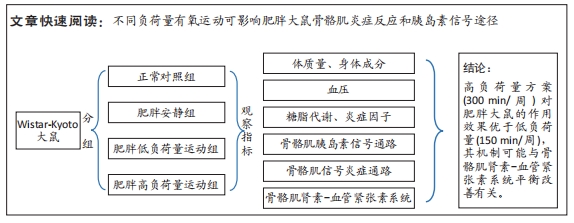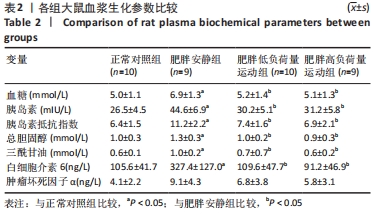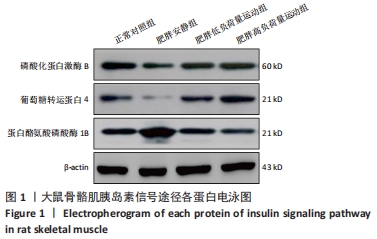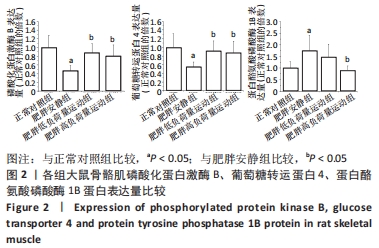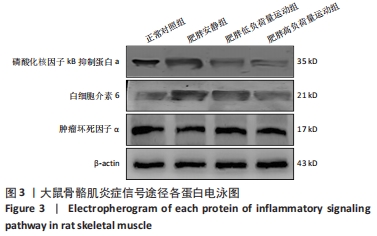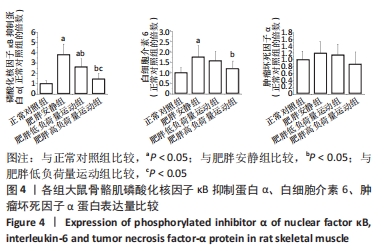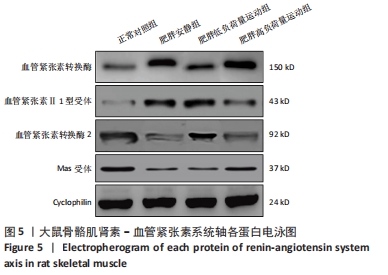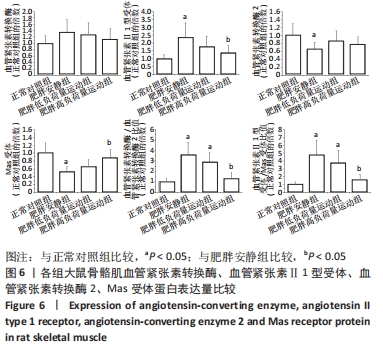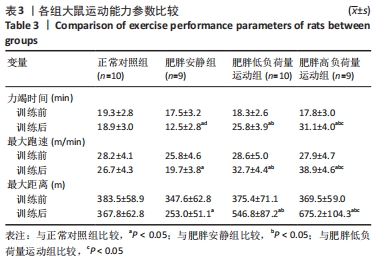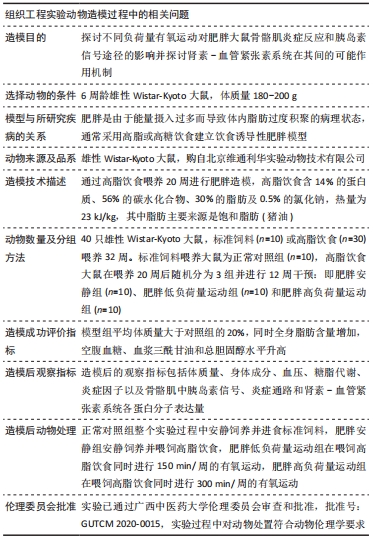[1] DONFRANCESCO C, PROFUMO E, LO NOCE C, et al. Trends of overweight, obesity and anthropometric measurements among the adult population in Italy: The CUORE Project health examination surveys 1998, 2008, and 2018. PLoS One. 2022;17(3):e0264778.
[2] KACHUR S, LAVIE CJ, DE SCHUTTER A, et al. Obesity and cardiovascular diseases. Minerva Med. 2017;108(3):212-228.
[3] WEI Y, SOWERS JR, CLARK SE, et al. Angiotensin II-induced skeletal muscle insulin resistance mediated by NF-kappaB activation via NADPH oxidase. Am J Physiol Endocrinol Metab. 2008;294(2):E345-E351.
[4] DI MEO S, IOSSA S, VENDITTI P. Improvement of obesity-linked skeletal muscle insulin resistance by strength and endurance training. J Endocrinol. 2017;234(3):R159-R181.
[5] PATEL S, RAUF A, KHAN H, et al. Renin-angiotensin-aldosterone (RAAS): the ubiquitous system for homeostasis and pathologies. Biomed Pharmacother. 2017;94:317-325.
[6] POWERS SK, MORTON AB, HYATT H, et al. The renin-angiotensin system and skeletal muscle. Exerc Sport Sci Rev. 2018;46(4):205-214.
[7] YANG T, XU C. Physiology and pathophysiology of the intrarenal renin-angiotensin system: an update. J Am Soc Nephrol. 2017;28(4):1040-1049.
[8] PAZ OCARANZA M, RIQUELME JA, GARCÍA L, et al. Counter-regulatory renin-angiotensin system in cardiovascular disease. Nat Rev Cardiol. 2020;17(2):116-129.
[9] YAMAMOTO K, TAKESHITA H, RAKUGI H. ACE2, angiotensin-(1-7) and skeletal muscle: review in the era of COVID-19. Clin Sci (Lond). 2020; 134(22):3047-3062.
[10] SHEIKH AM, VISSING J. Exercise therapy for muscle and lower motor neuron diseases. Acta Myol. 2019;38(4):215-232.
[11] SAKAMOTO M. Effects of physical agents on muscle healing with a focus on animal model research. Phys Ther Res. 2021;24(1):1-8.
[12] GOMES-SANTOS IL, FERNANDES T, COUTO GK, et al. Effects of exercise training on circulating and skeletal muscle renin-angiotensin system in chronic heart failure rats. PLoS One. 2014;9(5):e98012.
[13] THOMPSON PD, ARENA R, RIEBE D, et al. ACSM’s new preparticipation health screening recommendations from ACSM’s guidelines for exercise testing and prescription, ninth edition. Curr Sports Med Rep. 2013;12(4):215-217.
[14] WEN CP, WAI JP, TSAI MK, et al. Minimum amount of physical activity for reduced mortality and extended life expectancy: a prospective cohort study. Lancet. 2011;378(9798):1244-1253.
[15] FLACK KD, HAYS HM, MORELAND J, et al. Exercise for weight loss: further evaluating energy compensation with exercise. Med Sci Sports Exerc. 2020;52(11):2466-2475.
[16] NASCIMENTO AR, MACHADO M, DE JESUS N, et al. Structural and functional microvascular alterations in a rat model of metabolic syndrome induced by a high-fat diet. Obesity (Silver Spring). 2013; 21(10):2046-2054.
[17] 范朋琦, 秦永生, 彭朋. 不同运动方式对自发性高血压大鼠心脏重塑和运动能力的影响[J]. 现代预防医学,2018,45(23):4341-4345.
[18] 孟宪欣, 管泽毅, 葛吉生, 等. 间歇运动干预自发性高血压大鼠病理性心脏肥大:运动强度与健康效应的关系[J]. 体育科学,2019, 39(6):73-82.
[19] MATTHEWS DR, HOSKER JP, RUDENSKI AS, et al. Homeostasis model assessment: insulin resistance and beta-cell function from fasting plasma glucose and insulin concentrations in man. Diabetologia. 1985; 28(7):412-419.
[20] SILVA DM, GOMES-FILHO A, OLIVON VC, et al. Swimming training improves the vasodilator effect of angiotensin-(1-7) in the aorta of spontaneously hypertensive rat. J Appl Physiol (1985). 2011;111(5): 1272-1277.
[21] FILHO AG, FERREIRA AJ, SANTOS SH, et al. Selective increase of angiotensin(1-7) and its receptor in hearts of spontaneously hypertensive rats subjected to physical training. Exp Physiol. 2008;93(5):589-598.
[22] CHASTON TB, DIXON JB. Factors associated with percent change in visceral versus subcutaneous abdominal fat during weight loss: findings from a systematic review. Int J Obes (Lond). 2008;32(4):619-628.
[23] PETRIDOU A, SIOPI A, MOUGIOS V. Exercise in the management of obesity. Metabolism. 2019;92:163-169.
[24] WESTERTERP KR. Exercise, energy balance and body composition. Eur J Clin Nutr. 2018;72(9):1246-1250.
[25] WEWEGE MA, THOM JM, RYE KA, et al. Aerobic, resistance or combined training: A systematic review and meta-analysis of exercise to reduce cardiovascular risk in adults with metabolic syndrome. Atherosclerosis. 2018;274:162-171.
[26] ZACHAREWICZ E, HESSELINK M, SCHRAUWEN P. Exercise counteracts lipotoxicity by improving lipid turnover and lipid droplet quality. J Intern Med. 2018;284(5):505-518.
[27] SVEGLIATI-BARONI G, PIERANTONELLI I, TORQUATO P, et al. Lipidomic biomarkers and mechanisms of lipotoxicity in non-alcoholic fatty liver disease. Free Radic Biol Med. 2019;144:293-309.
[28] Baek KW, Cha HJ, Ock MS, et al. Effects of regular-moderate exercise on high-fat diet-induced intramyocellular lipid accumulation in the soleus muscle of Sprague-Dawley rats. J Exerc Rehabil. 2018;14(1):32-38.
[29] LI C, CULVER SA, QUADRI S, et al. High-fat diet amplifies renal renin angiotensin system expression, blood pressure elevation, and renal dysfunction caused by Ceacam1 null deletion. Am J Physiol Endocrinol Metab. 2015;309(9):E802-810.
[30] SCHÜTTEN MT, HOUBEN AJ, DE LEEUW PW, et al. The link between adipose tissue renin-angiotensin-aldosterone system signaling and obesity-associated hypertension. Physiology (Bethesda). 2017;32(3): 197-209.
[31] ALMEIDA JA, MOTTA-SANTOS D, PETRIZ BA, et al. High-intensity aerobic training lowers blood pressure and modulates the renal renin-angiotensin system in spontaneously hypertensive rats. Clin Exp Hypertens. 2020;42(3):233-238.
[32] ENDLICH PW, CLAUDIO ER, LIMA LC, et al. Exercise modulates the aortic renin-angiotensin system independently of estrogen therapy in ovariectomized hypertensive rats. Peptides. 2017;87:41-49.
[33] WEI Y, SOWERS JR, NISTALA R, et al. Angiotensin II-induced NADPH oxidase activation impairs insulin signaling in skeletal muscle cells. J Biol Chem. 2006;281(46):35137-35146.
[34] YOON KJ, ZHANG D, KIM SJ, et al. Exercise-induced AMPK activation is involved in delay of skeletal muscle senescence. Biochem Biophys Res Commun. 2019;512(3):604-610.
[35] SYLOW L, KLEINERT M, RICHTER EA, et al. Exercise-stimulated glucose uptake - regulation and implications for glycaemic control. Nat Rev Endocrinol. 2017;13(3):133-148.
[36] ELEFTHERIOU P, GERONIKAKI A, PETROU A. PTP1B inhibition, a promising approach for the treatment of diabetes type II. Curr Top Med Chem. 2019;19(4):246-263.
[37] ROPELLE ER, PAULI JR, PRADA PO, et al. Reversal of diet-induced insulin resistance with a single bout of exercise in the rat: the role of PTP1B and IRS-1 serine phosphorylation. J Physiol. 2006;577(Pt 3):997-1007.
[38] MEINEN S, LIN S, RUEGG MA. Angiotensin II type 1 receptor antagonists alleviate muscle pathology in the mouse model for laminin-α2-deficient congenital muscular dystrophy (MDC1A). Skelet Muscle. 2012;2(1):18-26.
[39] KUNNUMAKKARA AB, SHABNAM B, GIRISA S, et al. Inflammation, NF-κB, and chronic diseases: how are they linked? Crit Rev Immunol. 2020; 40(1):1-39.
[40] TIFTIK RN, TEMIZ-REŞITOĞLU M, GÜDEN DS, et al. Involvement of Rho-kinase/IκB-α/NF-κB activation in IL-1β-induced inflammatory response and oxidative stress in human chondrocytes. Can J Physiol Pharmacol. 2021;99(4):418-426.
[41] MORALES MG, ABRIGO J, ACUÑA MJ, et al. Angiotensin-(1-7) attenuates disuse skeletal muscle atrophy in mice via its receptor, Mas. Dis Model Mech. 2016;9(4):441-449.
|
